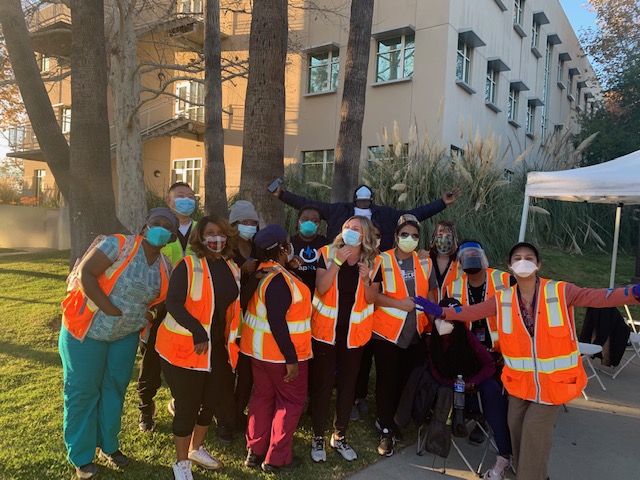A Day at the COVID Vaccine Center: Tales from an Endocrinologist
By Francine Kaufman
 By Dr. Francine Kaufman
By Dr. Francine Kaufman
What is it like to work in a large COVID-19 vaccination center in LA? How does being an endocrinologist help? What questions do people with diabetes ask? Dr. Kaufman shares her experience.
Often volunteer opportunities are life-affirming. For most of my medical career I have treated people with diabetes; having volunteered as a pediatric endocrinologist to work in many countries over many decades – including Haiti, where I helped run a camp for children with diabetes for years following the massive 2010 earthquake – I recently had the opportunity to help out again, closer to home., I had the opportunity to volunteer at an outdoor COVID-19 vaccination center in Los Angeles County. Given my work, I was particularly interested in learning what questions and concerns people with diabetes had as they received the vaccine.
After receiving my second dose of the COVID-19 vaccine two weeks before, I was empowered to spend my first weekend helping to vaccinate others. My day started early so I could check in, get my assignments, and put on protective gear. The training for what I was to do was accomplished just minutes before I was about to do it by incredibly dedicated nurses, many of whom were part of a large network of visiting nurses from all over the US. The quick training reminded me of my pediatric internship and residency when I was trained at the bedside of a patient, learning as I went.
At 7 a.m. in Los Angeles, the temperature was in the high 40s, and I was bundled as if I were on my way to the Alaskan tundra. By mid-morning, it was in the high 60s, and by the mid-afternoon, it was in the mid 70s, so I peeled off my layers of clothes as the day progressed. I was down to my Children’s Hospital of Los Angeles t-shirt, yoga pants, double masks, face shield, gloves, and an obligatory orange vest worn by construction workers and Bob the Builder, an icon of toddlers. I’m sure my vest illuminated in the dark although it remained shockingly bright all day in the piercing California sun.
The set up was amazing – everything was done in people’s cars. The line of vehicles wound around a series of orange cones, with required stops to register, get the vaccine, and then wait 15-30 minutes or more to assure there were no problematic reactions. At each stop, blue tape was applied to the car windshield indicating how many people in the car were to be vaccinated, timing of the vaccine, and time they could exit the parking lot after the obligatory observation period.
The first stop was to make sure the car occupants were scheduled and eligible for the vaccine that day. Prior to arriving, healthcare workers and people over age 65 had to book an appointment – they then had to show the appointment on their phone or a printout with the date and their name, and that name had to match their photo ID. If they were 65 or older, proving their age was easy; although I will admit, because its LA, some people looked significantly younger – masks cover up a lot. If the people were in line because they were health care workers, they had to prove it with badges, IDs, pay stubs, or verification that they were California-approved home health care workers. I felt bad turning away a veterinarian, a researcher, and a lab tech who had no direct patient contact. After all, I had my marching orders, and fair was fair.
Administering the vaccine through car windows was routine (a shot is a shot). It’s the handling of the vaccine (transporting it, thawing it, and loading the syringe) and the documentation (who was vaccinated, which lot of vaccine they received, and in which arm) that was time consuming and exacting. But the real fun was the last stop: the 15-30 minutes they had to wait to assure there were no unexpected reactions. Cars parked in a line about 6 to 12 deep and I walked back and forth, up and down that line for hours checking that everyone was alright.
I was routinely asked questions about adverse reactions and what to look for, but almost as frequently, I was asked about diabetes – I was wearing my Children’s Hospital of Los Angeles badge with my picture, name, and role, Endocrinologist. It seemed like the perfect fit for me and my line of cars. I was asked about high and low blood sugar after the vaccine, changing food and medications, managing stress or fever, strategies for glucose checks, and this plea: “Please tell my son this might be the perfect time for dessert.”
My responses were simple: some tenderness at the vaccination site might be expected, if you check your glucose levels this would be the perfect time for extra checks, pay careful attention to your symptoms, call your healthcare professional if there are concerns, and, I replied: “It’s just not up to me about dessert.” I got to see finger stick glucose levels and continuous glucose monitor (CGM) tracings from inside the car. None were alarming, and as always, I was glad I was an endocrinologist.
The most rewarding and life affirming aspect was how amazing it was to see 80- and 90-year-old vaccination-seekers driven into the center by their grandchildren or children, who so lovingly seemed thrilled to be part of the experience. One 87-year-old drove himself and his wife, whom he had been with for more than 65 years. He told me, “We wanted to vaccinate together.” But most impressive was the gratitude and the thanks I received as I peeled off the blue tape from the car windshield and handed it to them as a memento of the day.







